The Incredible Revival of Fort Worth, Texas
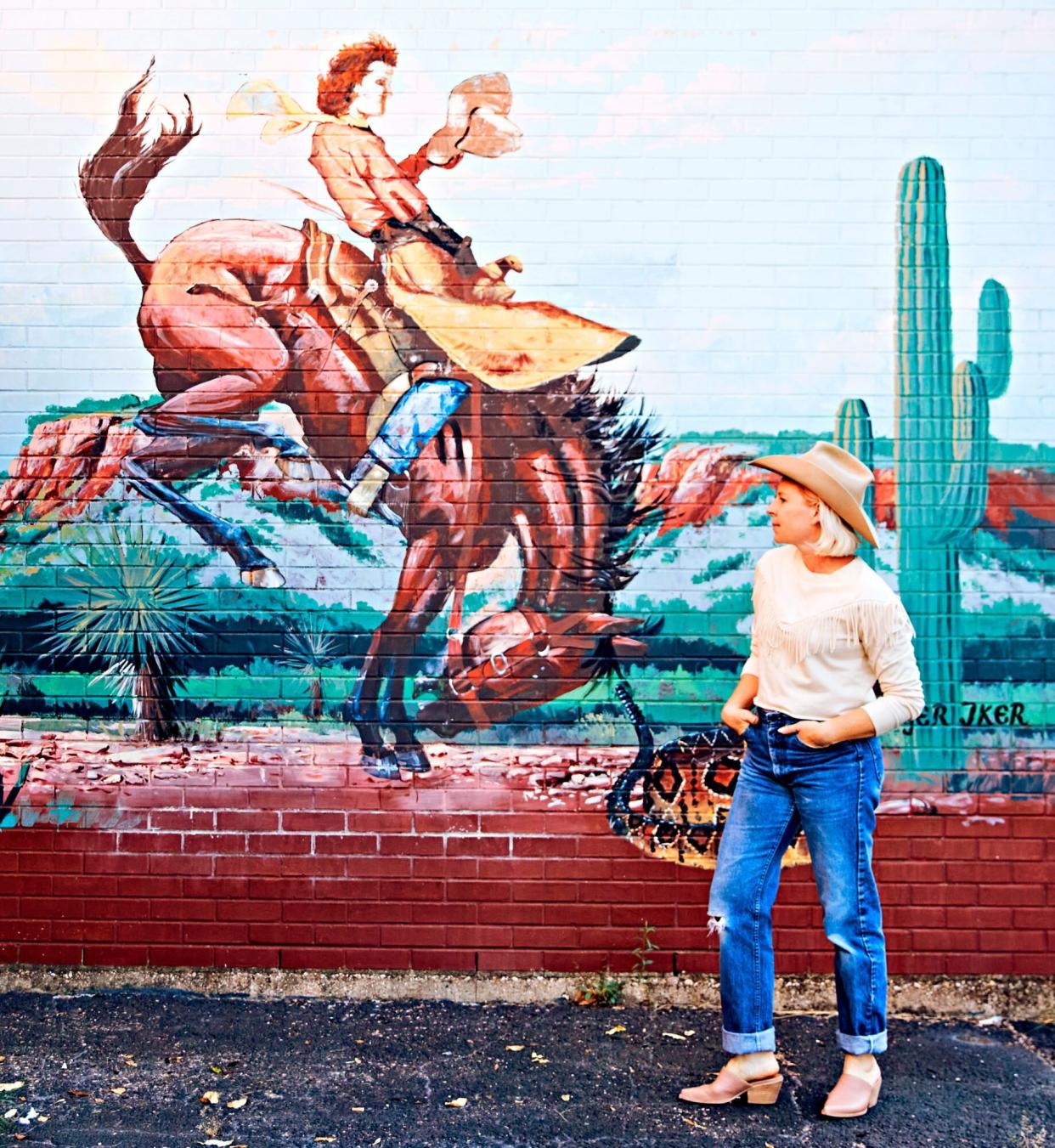
Scott Slusher Pose for pics with the many murals that adorn the city.
There was a time when Fort Worth was a much bigger deal than Dallas, its cosmopolitan sister city less than 40 miles away. People seem to forget that, but talk to any Texan working at a boot-and-tack shop, running the bar at a steak house, or leading a longhorn down the street at the Fort Worth Stockyards, and they'll be delighted to remind you—with a smile and pleasant conversation, of course. This is old Texas, and here they still heed the time-honored rules of real Southern hospitality. A tip of the hat and a firm handshake go a long way.
Back in the 1800s, when millions of cattle roamed wild Texas land and ranches, Fort Worth was the middle stopping point on the long journey to the railways and markets in the Midwest and beyond. After the railroad came to Fort Worth in 1876, it became a playground for both cowboys and infamous outlaws. They came to town to enjoy the rowdy riches of the booming local livestock exchange, which earned the city its nickname, Cowtown.
Despite the exploding growth in the past decade (from a younger incoming population) and a bustling corporate downtown, the historic end of Fort Worth—the one that reflects Texas' past—has remained largely the same. You'll still find remnants of a bygone era, like weekly rodeos, music-filled honky-tonks, and a working herd of hometown cattle. But now, Fort Worth's National Historic District is shaking off the dust with new museums, restaurants, watering holes, and a renovated entertainment hub, Mule Alley.
Don't get distracted by bigger, flashier cities down the highway. Fort Worth is a destination both charmingly stuck in time and pointed toward a flourishing future. Consider this town a 173-year history lesson on the birth of the Wild West, or just call it the perfect opportunity to pull out your leather boots again.
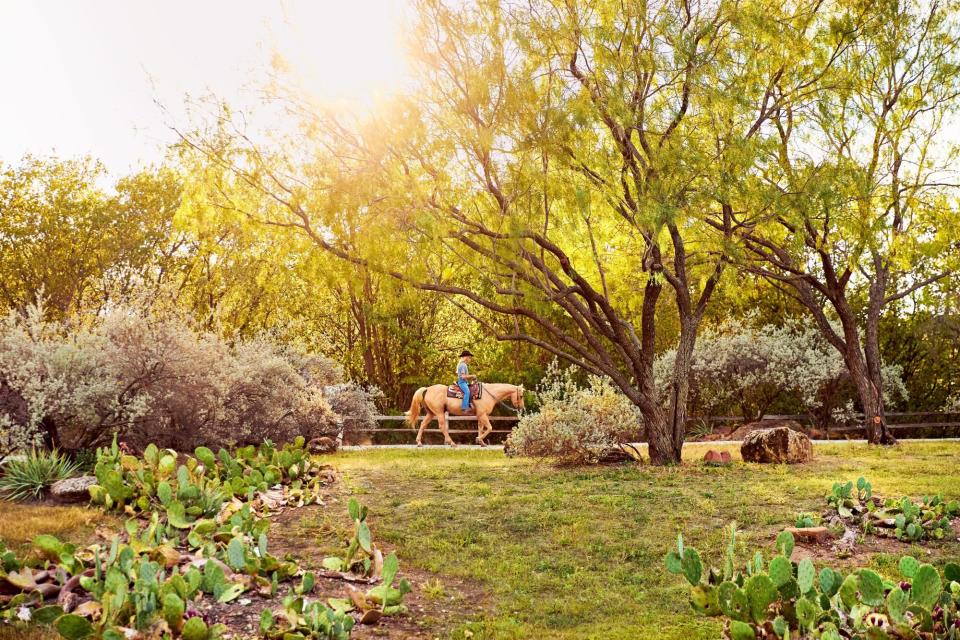
Scott Slusher Book a trip with Stockyards Stables, and saddle up for a ride on the banks of the Trinity River.
Welcome To Cowtown
"Never ever tell a Texan that they can't do something, okay?" warns Ed Brown, a tour guide who specializes in Stockyards history.
While talking about those who built up the city's first industry, Brown stands atop the original brick flooring that once saw thousands of cattle, horses, mules, pigs, and sheep being traded and shuttled off aboard trains like clockwork every day. In its prime, Fort Worth was the picture of business innovation and was known as the "Wall Street of the West."
Up and down Exchange Avenue, you'll see all of the 100-plus-year-old livestock buildings, but now they're occupied by souvenir shops, boot boutiques, and dimly lit steak houses enticing passersby with neon signage and the promise of a good time.
When Brown isn't acting out one of his many cowboy stories ("Remember, this is where the West began, after all," he repeats again and again), he's warming up the crowd before one of the two daily cattle drives that occur right down the main drag. Leashed at his heel is his sidekick, Boggy, a tiny black dog wearing an even tinier bull-riding costume.
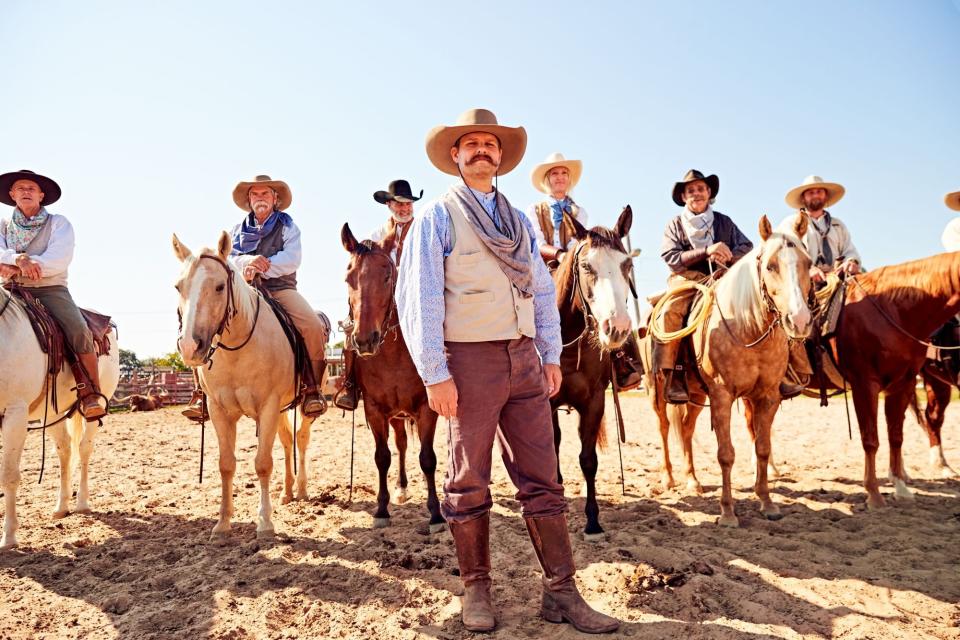
Scott Slusher The Fort Worth Herd’s cowhands are the real deal.
The Fort Worth Herd is made up of 17 longhorns, each one representing a decade of the Stockyards' history. It's the world's only twice-daily, year-round cattle drive.
Contrary to how you might think the average group of Texas drovers looked in the 19th century—rugged John Wayne types come to mind—these crews would have been diverse, often including Black Americans, Native Americans, Czech settlers, and women.
The Fort Worth Herd drovers strive to reflect that. "The cattle drive allows us to preserve and celebrate the special diversity that our Western heritage was built upon," says Kristin Jaworski, who has been the Fort Worth Herd Trail Boss for nearly 20 years.
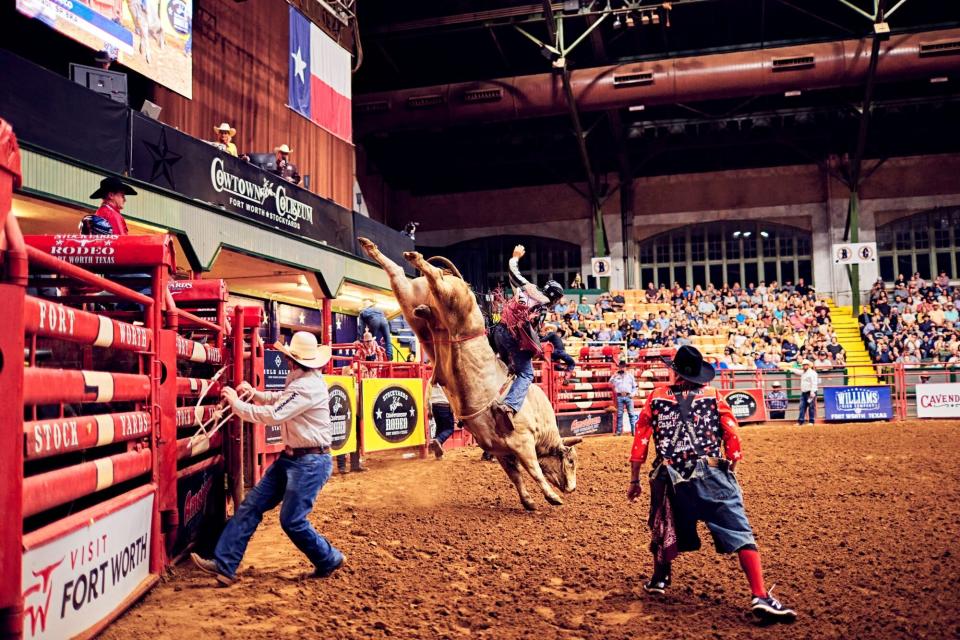
Scott Slusher Cowtown Coliseum houses The Bull Riding Hall of Fame.
Having stood for over a century, the Cowtown Coliseum has seen much more than horse shows. It can practically take credit for the way that Americans define the word "rodeo." The coliseum held the first indoor rodeo arena in the country, and the very first live radio broadcast of a rodeo was recorded here. The venue has also hosted historic performances by the likes of Elvis Presley and world-famous Italian opera singer Enrico Caruso. Each Friday and Saturday, you can still attend events that showcase barrel racing, roping, and crowd-favorite bull riding.
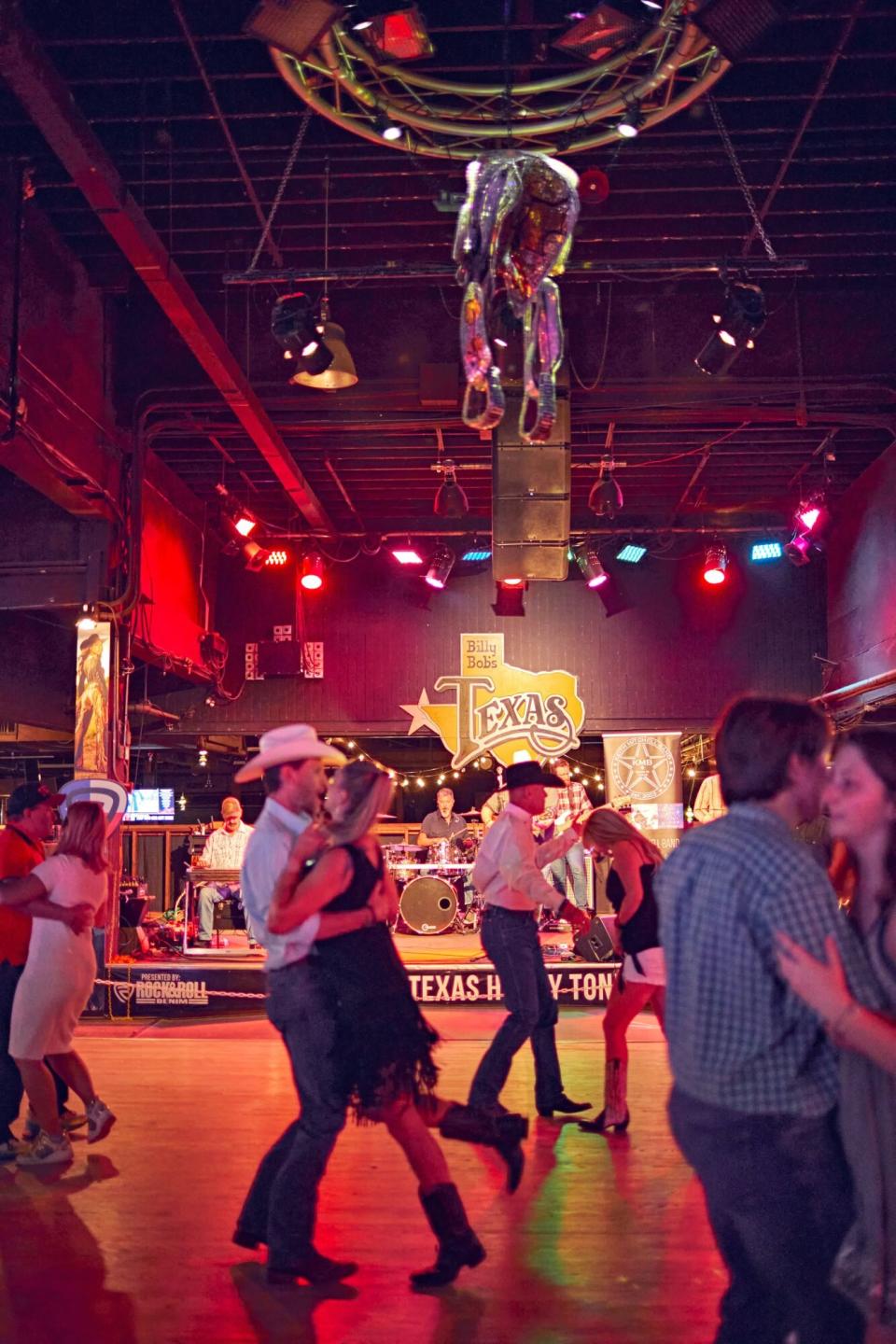
Scott Slusher Billy Bob’s Texas offers two-step and line dance lessons for beginners all year long.
You might hear a running joke about the Stockyards Championship Rodeo. It's said that when bull riders don't get the results they want, they just walk out the back and across the alley to Billy Bob's Texas, the world's largest honky-tonk. And they're not going there just to drown their sorrows. Inside the bar is a dirt-floored ring where professionals can keep bull riding the night away with a raucous crowd cheering them on. The animals here are live, not mechanical, so it's a real spectacle—even for Texans, which is saying something. Tucked away in the back (as much as it can be), the in-house rodeo is hidden enough that you could be two-stepping to live music by the stage without ever once seeing or hearing it. That's how big Billy Bob's is.
Lone Star Spirit
Fort Worth is no stranger to kicking up some dust, but it refuses to fade into it. After decades of watching historic buildings sit empty and in a sad state of disrepair, the city began a long road to restoration (that got a lot smoother recently thanks to extra funding) to help bring new restaurants, shops, and a swanky hotel to a previously neglected area dubbed Mule Alley.
Built into the Stockyards' refurbished horse and mule barns, Mule Alley is now a busy few blocks with lit-up storefronts that don't look nearly their age. You'll find heritage-brand stores like Lucchese Bootmaker and King Ranch Saddle Shop as well as Instagram-friendly food and drink spots where you'll most likely see more than one bachelorette party sporting hot pink, sparkly cowgirl hats. Grab a bottled cocktail in a souvenir flask from newly opened Second Rodeo Brewing, where the indoor-outdoor seating and bar consist of colorful lawn chairs on turf; it seems to make the live music even more enjoyable. (The on-tap grapefruit-infused ranch water is another tempting sipper.) Brunch is best taken at The Biscuit Bar. Have an order of the Hot Honey Biscuit with fried chicken and a cereal-milk cocktail.
Anchoring the renovation of Mule Alley, Hotel Drover is a 200-room property that opened last year and could be a getaway all on its own. Inside and out, it embodies old Texas style with an air of sophistication. Take a peek around the lush gardens to find in-house restaurant 97 West Kitchen & Bar or the accompanying Veranda Bar. With twinkling lights on the trees and cozy seating clustered around firepits, the property makes a quiet oasis, walkable to everything in the entertainment district.
You can mosey into any steak house near Exchange Avenue for an old-fashioned rib-eye meal (chef Tim Love's Lonesome Dove Western Bistro also offers other meats like rattlesnake and elk in a setting where you could easily imagine time-weathered ranchers talking shop). Or venture out of the historic district altogether to hit Heim BBQ for a plate of Texas' famed smoked meat. This city has always been in the business of beef, so it's only appropriate. While you're in that part of town, explore the Fort Worth Water Gardens and Sundance Square for shopping.
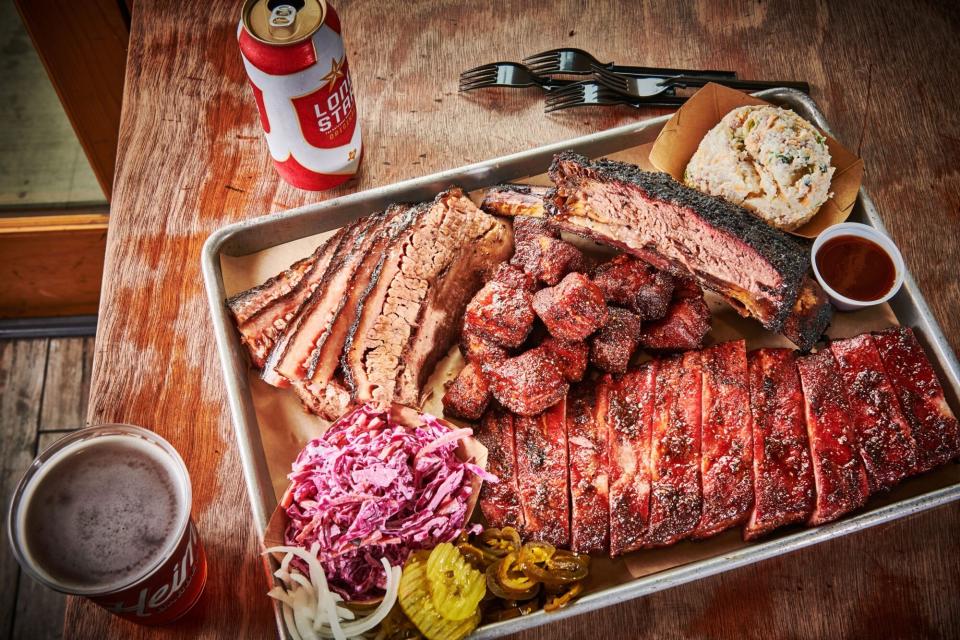
Elizabeth Lavin Heim BBQ’s popular menu items include Bacon Burnt Ends and Loaded Mac N’ Cheese.
Immerse yourself in Western culture one last time by visiting the recently opened museum next to Cowtown Coliseum, John Wayne: An American Experience. This exhibit gives you firsthand looks at the many prized personal possessions (including costumes, pictures, and correspondence) of Hollywood's most famous and beloved cowboy actor. Wayne's inspirational quotes are plastered on the walls, reminding visitors of his lasting impression on Texas and beyond.
The museum is just one of many ways that Fort Worth holds onto its roots while embracing the new. Even as it bustles with fresh energy, the city continues to honor those who built it from the saddle, like the drovers who tipped their hats and shook hands firmly. You might come for the rodeos and neon lights, but you can leave with something more.

